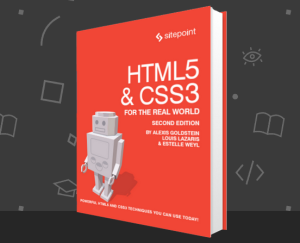If you have seen a decent number of websites in your life, you have surely noted a set of recurring widgets in most of them. Among these widgets are the search box, the newsletter widget, and the text box autocomplete widget. The latter is a widely used component, especially when the website needs a field that has several possible values but also needs to allow to create a completely new value. This component is so adopted that many JavaScript frameworks have their own autocomplete widget.
Until few years ago, there wasn’t a native HTML element to deal with this situation and developers have implemented the concept in different ways. This piece of the HTML puzzle isn’t lacking anymore. Today, we have an HTML element called datalist that serves this purpose. In this article, we’ll discover what it is and how to use it.
What’s the datalist Element?
The datalist element represents a set of option elements that embody predefined options for other controls.So, this element can be seen as a wrapper for a set of
options that express the possible values an input can assume, without restricting it to those values only. By default datalist and its children are hidden, so you won’t see them in a web page. In fact, datalist must be linked to another element through the use of a list attribute set on these other elements. The value of this attribute must be set to the ID of the datalist to use.
A simple example of HTML code that uses this element is shown below:
<input name="city" list="cities" />
<datalist id="cities">
<option value="Naples" />
<option value="London" />
<option value="Berlin" />
<option value="New York" />
<option value="Frattamaggiore" />
</datalist>input and a datalist element that contains several options. As you can see, the datalist has “cities” as its ID and the input is linked to it by using the list attribute (that has “cities” as its values as well).
A live demo of the code is shown below and available as a JSFiddle.
Due to its nature, this element lends itself well to be used in conjunction with JavaScript. For instance, you can perform Ajax requests to a server to retrieve relevant values based on the inputs of the user.
An example is shown in the demo below, available as a JSFiddle, where the options of datalist are dynamically generated.
So far, we’ve discussed how we can autocomplete textual fields, but this isn’t the only situation where we can employ this HTML element.
datalist and <input type="color">
The previous example is nice, but you can do even more with datalist. What if you want to suggest a color to your users through the use of <input type="color">? In this case, you can write the following code:
<input type="color" list="colors" />
<datalist id="colors">
<option value="#00000"/>
<option value="#478912"/>
<option value="#FFFFFF" />
<option value="#33FF99" />
<option value="#5AC6D9" />
<option value="#573905" />
</datalist>datalist and <input type="range">
Another example of use is in conjunction with a <input type="range"> element:
<input type="range" value="0" min="0" max="100" list="numbers" />
<datalist id="numbers">
<option value="20" />
<option value="40" />
<option value="60" />
<option value="80" />
</datalist>datalist.
A live demo of the code is shown below and available as a JSFiddle.
Browser Support
CanIUse shows howdatalist has very good support among desktop browsers. In fact, it’s supported by older versions of Firefox, Chrome, and Opera, and by Internet Explorer 10+. This means that you can reliably use it in your projects. Safari doesn’t support it, so Mac users are a bit unlucky.
There are few mobile browsers that have implemented the element. The only browsers that support it are Firefox and Chrome for mobile, and the last version of the Blackberry browser.
Polyfills
In case you want to provide support for this element in browsers that don’t understand it, you can use either Relevant Dropdowns or jQuery HTML5 datalist plugin. Keep in mind that these polyfills work only as a replacement in the cases that use a text field, meaning that you can’t polyfill ranges or colors.Conclusion
In this article I introduced you to thedatalist element and how it can be employed to create native autocomplete widgets. As you’ve seen in the examples shown, it can be used also with non-textual fields like colors and ranges. Finally, the support among browsers is good enough to adopt this element in production.
Did you know about this element? Have you ever used it? Let’s start a discussion.
Frequently Asked Questions (FAQs) on Creating Autocomplete Datalist Controls
How can I use the autocomplete attribute in datalist controls?
The autocomplete attribute is a global attribute that can be used in any HTML element, but it is particularly useful in form elements. It helps users by automatically completing the value of a field based on previous inputs. To use it in datalist controls, you simply add the attribute to your input tag and set its value to “on”. For example:<input list="browsers" name="browser" id="browser" autocomplete="on"><datalist id="browsers">
<option value="Internet Explorer">
<option value="Firefox">
<option value="Chrome">
<option value="Opera">
<option value="Safari"></datalist>
What are the benefits of using datalist controls in my web forms?
Datalist controls offer several benefits. They provide an autocomplete feature, which enhances user experience by making form filling faster and easier. They also improve data accuracy by limiting the user’s input to predefined options. Moreover, they are supported by most modern browsers, making them a reliable choice for web development.
How can I customize the appearance of my datalist controls?
Datalist controls can be customized using CSS. You can change the font, color, size, and other properties of the datalist and its options. However, keep in mind that the level of customization may vary across different browsers due to their different rendering engines.
Can I use datalist controls with other form elements?
Yes, datalist controls can be used with various form elements like text fields, number fields, and range sliders. You just need to associate the datalist with the form element using the list attribute.
How can I handle events in datalist controls?
You can handle events in datalist controls using JavaScript. For instance, you can use the onchange event to execute a function when the user selects an option from the datalist.
Are there any limitations or issues I should be aware of when using datalist controls?
While datalist controls are widely supported, there are some limitations and issues. For example, some older browsers do not support datalist controls. Also, the appearance and behavior of datalist controls can vary across different browsers.
How can I dynamically populate a datalist control?
You can dynamically populate a datalist control using JavaScript. You can fetch data from a server, create new option elements, and append them to the datalist.
Can I use multiple datalist controls in a single form?
Yes, you can use multiple datalist controls in a single form. Each datalist should have a unique id, and each input field should refer to the corresponding datalist using the list attribute.
How can I use datalist controls in a responsive design?
Datalist controls can be used in a responsive design just like any other HTML element. You can use CSS media queries to adjust the size and layout of the datalist controls based on the screen size.
Can I use datalist controls in a mobile web application?
Yes, datalist controls can be used in a mobile web application. However, the appearance and behavior of datalist controls may vary across different mobile browsers.
I'm a (full-stack) web and app developer with more than 5 years' experience programming for the web using HTML, CSS, Sass, JavaScript, and PHP. I'm an expert of JavaScript and HTML5 APIs but my interests include web security, accessibility, performance, and SEO. I'm also a regular writer for several networks, speaker, and author of the books jQuery in Action, third edition and Instant jQuery Selectors.



